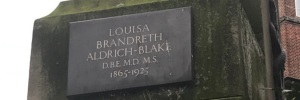The Adelphi Theatre, smack bang in the middle of London’s theatreland, holds many secrets; one of which is what happened to the leading actor of the Victorian era William Terriss? His ghost purportedly still haunts the theatre.
But what happened to William? Why did the nations’ favourite theatre actor lose his life at the hand of one of his colleagues and what happened to incite it?
After a number of short unsuccessful careers, Terriss was mistakenly identified as Prince Alfred, Queen Victoria’s second son, and loving the attention he’d received realised that he wanted to be an actor, for which he displayed a natural gift.
After trying out his acting abilities on unwitting fellow passengers whilst travelling on a train journey, not only did he annoy his elder brother Bob, a doctor, but also a woman who uttered the words “You unfeeling brute!” when she realised that his epileptic fit was in fact staged.
He rose to prominence and became the darling of London’s theatreland where the great and the good would come and see him perform. He was also very supportive of his fellow actors and would give generously to the Actors’ Benevolent Fund, a charity that still supports actors who are unable to work due to ill health or old age.
Terriss became acquainted with a younger actor named Richard Archer Prince, who had a history of mental illness and heavy drinking, but Terriss continued to help the struggling actor to find roles.
Prince had earned the nickname “Mad Archer” and during the run of ‘The Harbour Lights’ in which Terriss starred and Prince had a minor role, Terriss took offence to something that Prince had said about him and had the young actor dismissed. Terriss however, sent small sums of money to Prince via the actors’ benevolent fund and continued to try and find him acting work.
The career of “Breezy Bill” as Terriss was known, was cut short on Thursday, the 16th of December 1897, just before the evening performance of an English version of William Gillette’s drama, “Secret Service” at the Adelphi Theatre. “Mad Archer” stabbed him three times at the stage door of the Adelphi Theatre and he later died in the arms of his leading lady and mistress, Jessie Millwood. William Terriss had died at the height of his fame aged 50 years old.
Prince confessed to the murder and was expected to hang for his deeds, but the judge deemed him not of sound mind and being responsible for his own actions and sentenced him to life imprisonment in Broadmoor criminal lunatic asylum where it is said he liked to write and produce plays in which he always placed himself in the leading role. He died there in 1936 aged 71.
Terris was buried in a simple grave in Brompton cemetery following one of the grandest funeral processions seen in that time and was attended by all the leading theatrical personalities; the Bancrofts, Sir Henry Irving, Mr. Seymour Hicks (the deceased’s son-in-law) Mary Anderson and Lily Langtry to name but a few. The Prince of Wales was amongst those who sent a wreath, his being that of white lilies and orchids.
But what of the Adelphi Theatre?
Still functioning today as a very successful venue, it has an interesting history.
Situated on the Strand in London, it started life in 1806 as an extension to John Scott’s magic lantern shop. Scott made a lot of money inventing “Old True Blue” a clothes whitener, and using his wealth obtained a licence to put on plays with music. His small theatre was named “Sans Pareil” a very exotic name for a London theatre, but one that summoned up images of Paris and all the delights that city had to offer and the punters flocked in.
In 1819 Scott sold the (soon to be renamed) Adelphi and it put on shows written by amongst many others, Charles Dickens. In 1878, the restaurateur brothers, Agostino and Stefano Gatti bought the theatre license and after acquiring adjacent buildings opened ‘The Adelphi Theatre Restaurant’, a first-class dining establishment in 1887, which proved to be incredibly popular with theatregoers and other diners.
The theatre was on its way to great success.
But the Adelphi Theatre was not Terriss’s final performance. There have been numerous reported appearances by his ghost. The actor, June Howard Tripp starring in the musical ‘Clowns in Clover’ in 1928, reported that the couch in her dressing vibrated and that she felt a ghastly grip on her arm. Theatregoers that night also spoke of a green light manifesting on stage.
He has also been seen at Covent Garden tube station. A curious place for him to be given that the station wasn’t built until 1907. There have also been a number of papers regarding visitations made by the spirit of Terriss to Ghost Club members as reported by the British library. There is a link in the show notes to follow those through.
A portrait of William Terriss still hangs in the staircase of Denville Hall, the home for retired actors and actresses in Northwest London.
You can find out more about William Terriss, his ghostly goings on and The Adelphi Theatre in Episode 69 of our London History podcast.



